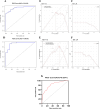Predicting the potentially exacerbation of severe viral pneumonia in hospital by MuLBSTA score joint CD4 + and CD8 +T cell counts: construction and verification of risk warning model
- PMID: 38811907
- PMCID: PMC11137986
- DOI: 10.1186/s12890-024-03073-y
Predicting the potentially exacerbation of severe viral pneumonia in hospital by MuLBSTA score joint CD4 + and CD8 +T cell counts: construction and verification of risk warning model
Abstract
Purpose: This study mainly focuses on the immune function and introduces CD4+, CD8+ T cells and their ratios based on the MuLBSTA score, a previous viral pneumonia mortality risk warning model, to construct an early warning model of severe viral pneumonia risk.
Methods: A retrospective single-center observational study was operated from January 2021 to December 2022 at the People's Hospital of Liangjiang New Area, Chongqing, China. A total of 138 patients who met the criteria for viral pneumonia in hospital were selected and their data, including demographic data, comorbidities, laboratory results, CT scans, immunologic and pathogenic tests, treatment regimens, and clinical outcomes, were collected and statistically analyzed.
Results: Forty-one patients (29.7%) developed severe or critical illness. A viral pneumonia severe risk warning model was successfully constructed, including eight parameters: age, bacterial coinfection, CD4+, CD4+/CD8+, multiple lung lobe infiltrations, smoking, hypertension, and hospital admission days. The risk score for severe illness in patients was set at 600 points. The model had good predictive performance (AUROC = 0.94397), better than the original MuLBSTA score (AUROC = 0.8241).
Conclusion: A warning system constructed based on immune function has a good warning effect on the risk of severe conversion in patients with viral pneumonia.
Keywords: MuLBSTA score; Viral pneumonia; Warning system.
© 2024. The Author(s).
Conflict of interest statement
The authors declare no competing interests.
Figures



Similar articles
-
[Analysis of the clinical characteristics and early warning model construction of severe/critical coronavirus disease 2019 patients].Zhonghua Wei Zhong Bing Ji Jiu Yi Xue. 2020 Apr;32(4):401-406. doi: 10.3760/cma.j.cn121430-20200325-00410. Zhonghua Wei Zhong Bing Ji Jiu Yi Xue. 2020. PMID: 32527341 Chinese.
-
MuLBSTA score is a useful tool for predicting COVID-19 disease behavior.J Infect Chemother. 2021 Feb;27(2):284-290. doi: 10.1016/j.jiac.2020.10.013. Epub 2020 Oct 13. J Infect Chemother. 2021. PMID: 33129694 Free PMC article.
-
Evaluation of the Risk Prediction Tools for Patients With Coronavirus Disease 2019 in Wuhan, China: A Single-Centered, Retrospective, Observational Study.Crit Care Med. 2020 Nov;48(11):e1004-e1011. doi: 10.1097/CCM.0000000000004549. Crit Care Med. 2020. PMID: 32897668 Free PMC article.
-
CD4 and CD8 Lymphocyte Counts as Surrogate Early Markers for Progression in SARS-CoV-2 Pneumonia: A Prospective Study.Viruses. 2020 Nov 9;12(11):1277. doi: 10.3390/v12111277. Viruses. 2020. PMID: 33182268 Free PMC article.
-
Suppressed T cell-mediated immunity in patients with COVID-19: A clinical retrospective study in Wuhan, China.J Infect. 2020 Jul;81(1):e51-e60. doi: 10.1016/j.jinf.2020.04.012. Epub 2020 Apr 18. J Infect. 2020. PMID: 32315725 Free PMC article.
References
-
- Grieco DL, Maggiore SM, Roca O, Spinelli E, Patel BK, Thille AW, Barbas CSV, de Acilu MG, Cutuli SL, Bongiovanni F, et al. Non-invasive ventilatory support and high-flow nasal oxygen as first-line treatment of acute hypoxemic respiratory failure and ARDS. Intensive Care Med. 2021;47(8):851–866. doi: 10.1007/s00134-021-06459-2. - DOI - PMC - PubMed
Publication types
MeSH terms
Grants and funding
LinkOut - more resources
Full Text Sources
Research Materials
Miscellaneous

